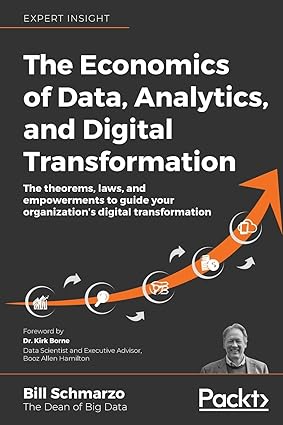In today's data-driven world, organizations are increasingly recognizing the transformative power of data, analytics, and digital technologies. However, the path to successful digital transformation is often fraught with challenges, including complex technical considerations, organizational resistance, and unforeseen costs. This white paper aims to provide a comprehensive framework, grounded in economic principles and practical insights, to guide organizations through their digital journeys.
The Economics of Data, Analytics, and Digital Transformation: A Comprehensive Guide
Introduction
In today's data-driven world, organizations are increasingly recognizing the transformative power of data, analytics, and digital technologies. However, the path to successful digital transformation is often fraught with challenges, including complex technical considerations, organizational resistance, and unforeseen costs. This white paper aims to provide a comprehensive framework, grounded in economic principles and practical insights, to guide organizations through their digital journeys.
Part I: The Economics of Data
1.1 The Value of Data
- Data as an Asset: Exploring the concept of data as a valuable asset, similar to tangible assets like property or equipment.
- Data Valuation Frameworks: Discussing various methods for quantifying the economic value of data, including cost-benefit analysis, revenue generation, and risk mitigation.
- Data Monetization Strategies: Identifying strategies for generating revenue from data, such as data licensing, data marketplaces, and data-driven product development.
1.2 The Network Effect of Data
- Metcalfe's Law and Data: Applying Metcalfe's Law to the realm of data, highlighting the exponential increase in value as the number of users and data sources grows.
- Platform Business Models: Analyzing how data-driven platforms can leverage network effects to create sustainable competitive advantages.
- Data Ecosystems: Understanding the importance of fostering data ecosystems and collaborating with partners to enhance data value.
Part II: The Power of Analytics
2.1 The Analytics Advantage
- Data-Driven Decision Making: Demonstrating how data analytics can improve decision-making accuracy and speed.
- Predictive Analytics and Forecasting: Utilizing predictive analytics to anticipate future trends and optimize business operations.
- Prescriptive Analytics and Optimization: Employing prescriptive analytics to identify the best course of action and maximize outcomes.
2.2 The Economics of AI and Machine Learning
- AI-Driven Innovation: Exploring the potential of AI and machine learning to drive innovation and create new business opportunities.
- Cost-Benefit Analysis of AI Investments: Assessing the economic impact of AI initiatives, including cost savings, revenue generation, and efficiency gains.
- Ethical Considerations in AI: Addressing the ethical implications of AI and the need for responsible AI development and deployment.
Part III: Digital Transformation and Its Economic Impact
3.1 The Digital Transformation Imperative
- Digital Disruption: Analyzing the disruptive forces of digital technologies and their impact on industries.
- The Digital Transformation Journey: Outlining the key stages of digital transformation, from strategy development to implementation and ongoing optimization.
- The Role of Leadership in Digital Transformation: Identifying the leadership qualities and skills required to drive successful digital transformations.
3.2 The Economic Benefits of Digital Transformation
- Increased Efficiency and Productivity: Exploring how digital technologies can streamline operations and boost productivity.
- Enhanced Customer Experience: Demonstrating the positive impact of digital transformation on customer satisfaction and loyalty.
- New Revenue Streams: Identifying opportunities for creating new revenue streams through digital innovation.
3.3 The Challenges and Risks of Digital Transformation
- Technical Challenges: Discussing the technical hurdles associated with digital transformation, such as data integration, cybersecurity, and cloud migration.
- Organizational Challenges: Addressing the organizational challenges, including resistance to change, skill gaps, and cultural barriers.
- Financial Risks: Identifying the financial risks of digital transformation and strategies for mitigating them.
Part IV: Empowering Your Organization for Digital Success
4.1 Building a Data-Driven Culture
- Data Literacy: Fostering a data-literate workforce through training and education.
- Data Governance: Establishing effective data governance practices to ensure data quality, security, and compliance.
- Data-Driven Decision Making: Promoting a culture of data-driven decision making at all levels of the organization.
4.2 Investing in Digital Talent
- Talent Acquisition and Retention: Attracting and retaining top digital talent.
- Upskilling and Reskilling: Investing in employee training and development to bridge skill gaps.
- Building a Data Science Team: Assembling a skilled data science team to drive data-driven insights.
4.3 Measuring the ROI of Digital Transformation
- Key Performance Indicators (KPIs): Identifying relevant KPIs to track the progress and impact of digital initiatives.
- Return on Investment (ROI) Analysis: Calculating the ROI of digital investments and justifying future expenditures.
- Continuous Improvement: Implementing a continuous improvement framework to optimize digital initiatives and maximize ROI.
Conclusion
By embracing the economic principles outlined in this white paper, organizations can navigate the complexities of digital transformation and unlock its full potential. By investing in data, analytics, and digital technologies, organizations can drive innovation, improve efficiency, and create sustainable competitive advantages.
References
1.0 The Economics of Data, Analytics, and Digital Transformation: The theorems, laws, and empowerments to guide your organization's digital transformation - Bill Schmarzo
2.0 Rewired: The McKinsey Guide to Outcompeting in the Age of Digital and AI- Eric Lamarre
Note: This is a comprehensive outline for a white paper. We are working on this paper as we speak To create a truly in-depth document, you will need to conduct extensive research, analyze case studies, and incorporate expert insights. Consider consulting with data scientists, economists, and business leaders to gain valuable perspectives. Contact keencomputer.com for details.
